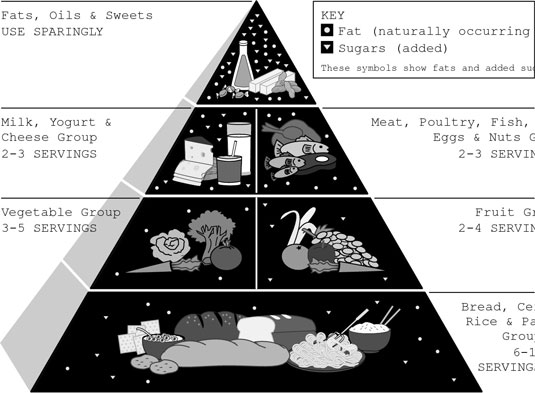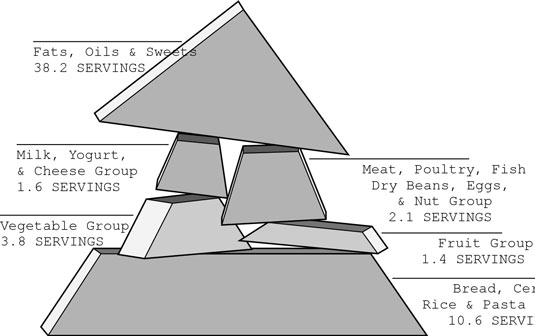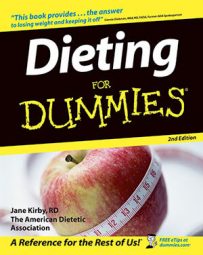The Food Guide Pyramid contains the building blocks for a healthy diet. If you follow the recommended servings listed for each food group in the pyramid each day and eat lowfat, low-sugar, and low-sodium choices within each group, you’re sure to get enough protein, vitamins, minerals, and dietary fiber without getting excessive amounts of calories, fat, saturated fat, cholesterol, sodium, added sugars, or alcohol.

Put the Dietary Guidelines into practice with the Food Guide Pyramid.
The USDA folks figured that the pyramid illustrated proportion as well as balance, variety, and moderation — the key features of a healthy diet. In focus group tests, the pyramid was easiest for most people to understand. However, not everyone agrees that the shape works.
Though several countries have adopted the pyramid, China and Korea use a pagoda, Canada uses a rainbow, Great Britain and Mexico use a plate, and Australia, Sweden, and most of Europe use a pie chart. Sure, they may look different, but all recommend that consumers eat plenty of grains, vegetables, and fruits, and moderate amounts of meat and dairy.
Notice that a range of servings is given for each block, or food group, of the pyramid. The serving sizes are designed to help people maintain their weights depending on how active they are. The lower number is intended to provide adequate nutrition for sedentary women, and the upper limit is for active teenage boys. Individuals who want to lose weight need to stick to the lower number of servings and sometimes go lower still.
Hate the idea of counting calories? If you use the lower range of servings suggested in the pyramid, you’d be eating about 1,600 calories; the large number of servings totals 2,800 calories.
Fats and added sugars are concentrated in foods located at the tip of the pyramid. But they’re also in foods found in the other food groups. When you choose foods for a healthy weight-loss diet, take the amount of fat and added sugars in those foods into consideration.
Choose lowfat foods from each of the food groups.
Go easy on fats and sugars added to foods in cooking and at the table.
Choose fewer foods that are high in sugars — candy, soft drinks, and sweet desserts.
Using the pyramid can help you identify where the bulk of your calories are coming from. Unfortunately, many people create a top-heavy pyramid by eating too much fat and sugar and not enough grains, fruits, and vegetables, as shown in the Actual Consumption Pyramid.


